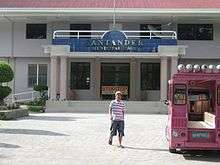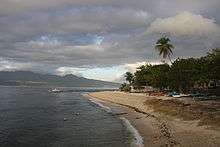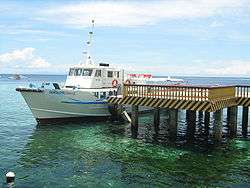Santander, Cebu
| Santander Tañong | |
|---|---|
| Municipality | |
|
Fast craft terminal in Liloan | |
 Map of Cebu with Santander highlighted | |
.svg.png) Santander Location within the Philippines | |
| Coordinates: 9°27′N 123°20′E / 9.45°N 123.33°ECoordinates: 9°27′N 123°20′E / 9.45°N 123.33°E | |
| Country | Philippines |
| Region | Central Visayas (Region VII) |
| Province | Cebu |
| District | 2nd district of Cebu |
| Founded | 1867 |
| Barangay | 10 (see § Barangays) |
| Government [1] | |
| • Type | Sangguniang Bayan |
| • Mayor | Marilyn Wenceslao (LP) |
| • Vice mayor | Wilson Wenceslao |
| • Town Council |
Members
|
| • Representative | Wilfredo Caminero |
| Area[2] | |
| • Total | 35.67 km2 (13.77 sq mi) |
| • Land | 29.53 km2 (11.40 sq mi) |
| Elevation | 200 m (700 ft) |
| Population (2015 census)[3] | |
| • Total | 17,857 |
| • Density | 500/km2 (1,300/sq mi) |
| • Voter (2016)[4] | 11,577 |
| Demonym(s) | Tañonganon |
| Time zone | PST (UTC+8) |
| ZIP code | 6026 |
| IDD : area code | +63 (0)32 |
| Income class | 4th class |
| PSGC | 072245000 |
| Website |
santander |
Santander is a 4th municipal income class municipality in the province of Cebu, Philippines. According to the 2015 census, it has a population of 17,857.[3] In the 2016 election, it had 11,577 registered voters.[4]
Santander is the southernmost municipality of Cebu, at 137 km (85 mi) by road, and which takes 3½-4 hours. It is the location of sea ports that connect to Negros Oriental. Fast craft ferry passengers to Sibulan, with trips taking 20 minutes. Roll-on roll-off barges travel to Amlan, with trips taking one hour.
It is known for its Tostado Festival.
History
Santander is at the southernmost tip of Cebu. The town was originally called Tañong, but with the coming of the Spaniards, it was renamed Santander, after the city on the northern (Atlantic) coast of Spain.
The town was established in 1867; the parish in 1897.
Geography
Santander's terrain is dominated by a backdrop of rugged ranges which raise from a flat narrow coastal plain to an average elevation of 200 metres (660 ft). Strongly sloping to sleepy sloping contours are scattered throughout the municipality.
Barangays
Santander comprises 10 barangays:
|
| |||||||||||||||||||||||||||||||||||||||||||||||||||||||||||||||||||||||||||||||||||||||||
Demographics
| Population census of Santander | |||||||||||||||||||||||||
|---|---|---|---|---|---|---|---|---|---|---|---|---|---|---|---|---|---|---|---|---|---|---|---|---|---|
|
| ||||||||||||||||||||||||
| Source: Philippine Statistics Office[3][5][6] | |||||||||||||||||||||||||
In the 2016 election, it had 11,577 registered voters, meaning that 65% of the population are aged 18 and over.[4]
The death rate is 3.06 per 1000 people, or 0.306%.
Language
Most of the Tañonganons (people living in Santander) speak Cebuano (Santander Version). In schools, Filipino and English languages are taught and used as a major instruction in all subjects.
Economy

Santander may be the third smallest town in Cebu, but it has turned out many professionals. Majority of the people depend on the sea for livelihood – fishermen who continually explore the vast Palawan and East Philippine seas in search for rich fishing grounds. The method of fishing used is the destructive muro-ami technique, which has been banned on several occasions due to its negative effects on marine life.
Before, there were four wholesale enterprises, one superstore and few sari-sari stores. An improvised market composed mostly of "talipapas" serves as satellite mater. This were located along Jose Rizal Street beside the Municipal building. By the year 2001, the business establishments began to grow and develop. Many larger businesses have been established in Santander such as LGC Marketing. The major agricultural produce in Santander is corn, copra, and root crops (cassava and sweet potato). Most people especially those living in mountain barangays plant corns as a source of their income and livelihood.
Santander was the only 5th class and small municipality in Cebu that promoted its income class from 5th to 4th class.
Transport
Before, there were only two ports in Santander serving barges and boats bound for Dumaguete City. Now there are 4 ports connecting to Negros Island – three are located at Liloan and one at Talisay.
Education
There are 8 elementary and 3 high schools in Santander. Two of these schools are private located in Looc. Most of the Tañonganon students are enrolled in public schools especially in Santander Central Elementary School and Santander National School.
Sports
Basketball is the most popular sport in Santander. This game is usually played in the afternoons where school time is over and also for the adults whose work hours is done (specially construction works). During summer, a lot of basketball competitions between different barangays. This was done in order that youths avoid vices and illegal drugs. Volleyball is also played in summer competitions but it is more usually participated in by women. Other sports such as baseball and football are also played in Santander.
Tourism

Santander's popularity as a tourist destination has increased in the past few years, since it serves as the hub for some world-renowned dive spots like Apo Island, Balicasag, Pescador Island, Sumilon and Siquijor. This is also reflected in the growth of Santander in the tourism industry. 6 years ago there were only two resorts, still open today. Today there are eleven.
References
- ↑ "Municipality". Quezon City, Philippines: Department of the Interior and Local Government. Retrieved 31 May 2013.
- ↑ "Municipal: Santander, Cebu". PSGC Interactive. Quezon City, Philippines: Philippine Statistics Authority. Retrieved 8 January 2016.
- 1 2 3 4 "Region VII (CENTRAL VISAYAS)". Census of Population (2015): Total Population by Province, City, Municipality and Barangay (Report). PSA. Retrieved 20 June 2016.
- 1 2 3 "2016 National and Local Elections Statistics". Commission on Elections. 2016.
- 1 2 "Region VII (CENTRAL VISAYAS)". Census of Population and Housing (2010): Total Population by Province, City, Municipality and Barangay (Report). NSO. Retrieved 29 June 2016.
- ↑ "Region VII (CENTRAL VISAYAS)". Census of Population (1995, 2000 and 2007): Total Population by Province, City and Municipality (Report). NSO. Archived from the original on 24 June 2011.
| Wikimedia Commons has media related to Santander. |
External links
 |
Samboan | Oslob |  | |
| Amlan, Negros Oriental ⛴ Tañon Strait | |
Bohol Sea | ||
| ||||
| | ||||
| San Jose, Negros Oriental ⛴ Tañon Strait | Tañon Strait ⛴ Sibulan, Negros Oriental |

